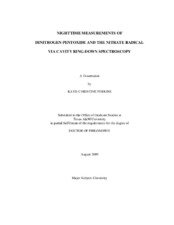| dc.description.abstract | Development of effective pollution control strategies for urban areas requires
accurate predictive models. The ability of models to correctly characterize the
atmospheric chemistry, meteorology, and deposition rely on accurate data
measurements, both as input and verification of output. Therefore, the measurement
techniques must be sensitive, accurate, and capable of resolving the spatial and temporal
variations of key chemical species. The application of a sensitive in situ optical
absorption technique, known as cavity ring-down spectroscopy, will be introduced for
simultaneously measuring the nitrate radical and dinitrogen pentoxide.
The cavity ring-down spectrometer was initially designed and constructed based
on the experiments by Steven Brown and Akkihebal Ravishankara at the National
Oceanic and Atmospheric Administration. The instrument design has since undergone
many revisions before attaining the current instrumentation system. Laboratory
observations provide verification of accurate N2O5 and NO3 detection with
measurements of the nitrate radical absorption spectrum centered at 662 nm, effective
chemical zeroing with nitric oxide, and efficient thermal decomposition of N2O5. Field
observations at a local park provided further confirmation of the instruments capability in measuring N2O5 and NO3. However, detection limits were too high to detect ambient
NO3. Effective and frequent zeroing can easily improve upon the sensitivity of the
instrument. Determination of the source of the polluted air masses detected during these
studies was unknown since the typical southerly winds from Houston were not observed.
Since deployment in the field, instrumentation modifications and laboratory
measurements are underway for preparation of the SOOT campaign in Houston, Texas
starting April 15, 2009. Current modifications include automation of the titration with a
solenoid valve and an automated filter changer. Wall losses and filter transmission for
NO3 and N2O5 will be determined through laboratory measurements in coincidence with
and ion-drift chemical ionization mass spectrometer prior to the SOOT project. Potential
modifications to improve upon the instrument are suggested for future endeavors. | en |


